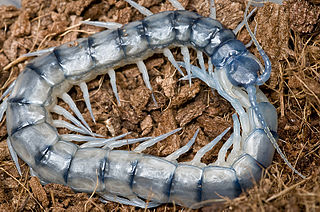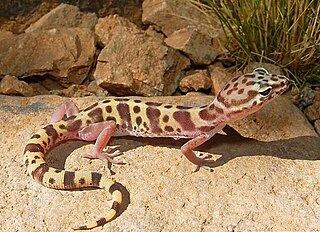
Centipedes are predatory arthropods belonging to the class Chilopoda of the subphylum Myriapoda, an arthropod group which also includes millipedes and other multi-legged creatures. Centipedes are elongated metameric creatures with one pair of legs per body segment. Most centipedes are generally venomous and can inflict painful bites, injecting their venom through pincer-like appendages known as forcipules. Despite the name, centipedes can have a varying number of legs, ranging from 30 to 354. Centipedes always have an odd number of pairs of legs. Therefore, no centipede has exactly 100 legs. Like spiders and scorpions, centipedes are predominantly carnivorous.

Leach's storm petrel or Leach's petrel is a small seabird of the tubenose order. It is named after the British zoologist William Elford Leach. The scientific name is derived from Ancient Greek. Hydrobates is from hydōr "water", and batēs "walker", and leucorhous is from leukos, "white" and orrhos, "rump". It was formerly defined in the genus Oceanodroma before that genus was synonymized with Hydrobates.
William Elford Leach, MD, FRS was an English zoologist and marine biologist.

Scutigera coleoptrata is a conspicuous, typically yellowish-grey centipede with up to 15 pairs of long legs. Originating in the Mediterranean region, the species has spread to other parts of the world, where it can live in human homes, thus gaining the name house centipede. It is an insectivore; it kills and eats other arthropods, such as insects and arachnids.

Scolopendra heros, commonly known as the giant desert centipede, giant Sonoran centipede, Texas redheaded centipede, and giant redheaded centipede, is a species of North American centipede found in the Southwestern United States and Northern Mexico.

The common frog, also known as the European common frog, European common brown frog, European grass frog, European Holarctic true frogs, European pond frogs or European brown frogs, is a semi-aquatic amphibian of the family Ranidae, found throughout much of Europe as far north as Scandinavia and as far east as the Urals, except for most of Iberia, Southern Italy, and the southern Balkans. The farthest west it can be found is Ireland. It is also found in Asia, and eastward to Japan.

The Chinese red-headed centipede, also known as the Chinese red head, is a centipede from East Asia and Australasia. It averages 20 cm (8 in) in length and lives in damp environments.

Lithobius is a large genus of centipedes in the family Lithobiidae, commonly called stone centipedes, common centipedes or brown centipedes.

Lithobius forficatus, most commonly known as the brown centipede or stone centipede, is a common European centipede of the family Lithobiidae, although its distribution is not exclusive to Europe. It is between 18 and 30 mm long and up to 4 mm broad and is a chestnut brown color.

Scolopendra subspinipes is a species of very large centipede found throughout eastern Asia. One of the most widespread and common species in the genus Scolopendra, it is also found on virtually all land areas around and within the Indian Ocean, all of tropical and subtropical Asia from Russia to the islands of Malaysia and Indonesia, Australia, South and Central America, the Caribbean islands, and possibly parts of the southern United States, but how much of this range is natural and how much due to human introduction is unclear. With a wide geographic range and numerous color variations, the species is known by a great many common names, including Chinese red-headed centipede,jungle centipede, orange-legged centipede, red-headed centipede,, Hawaiian centipede, and Vietnamese centipede.

Scolopendra is a species-rich genus of large tropical centipedes of the family Scolopendridae.

Glomeris marginata is a common European species of pill millipede. It is a short millipede, rounded in cross-section, which is capable of rolling itself up into a ball ("volvation") when disturbed. This behaviour is also found in the pill woodlouse Armadillidium, with which G. marginata is often confused.

Tachypodoiulus niger, known variously as the white-legged snake millipede or the black millipede, is a European species of millipede. It is very similar to other species such as Cylindroiulus londinensis, from which it can be reliably distinguished only by studying the shape of the telson. It occurs in Ireland, Britain, Spain, France, Benelux, Germany, Switzerland, Austria and the Czech Republic, and is especially common on chalky and limestone soils.

The western banded gecko is a species of gecko found in the southwestern United States and northern Mexico. Five subspecies are recognized.

Trichoniscus pusillus, sometimes called the common pygmy woodlouse, is one of the five most common species of woodlice in the British Isles. It is acknowledged to be the most abundant terrestrial isopod in Britain. It is found commonly across Europe north of the Alps, and has been introduced to Madeira, the Azores and North America.

Julida is an order of millipedes. Members are mostly small and cylindrical, typically ranging from 10–120 millimetres (0.39–4.72 in) in length. Eyes may be present or absent, and in mature males of many species, the first pair of legs is modified into hook-like structures. Additionally, both pairs of legs on the 7th body segment of males are modified into gonopods.

Cryptops hortensis is a species of centipede in the family Cryptopidae, genus Cryptops. This species is found in all of Europe except for: the Baltic states, Andorra, Belarus, Liechtenstein, Luxembourg, Moldova, Russia, Vatican City and various European islands.

Meloe variegatus is a European oil beetle. It is commonly known as the variegated oil beetle. Adult beetles feed on leaves and can be pests of crops, while the larvae are parasitic on solitary bees.















